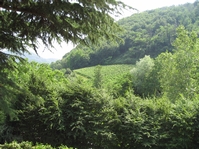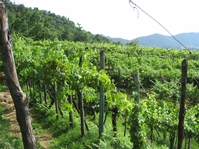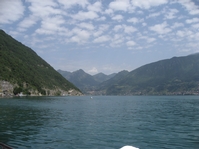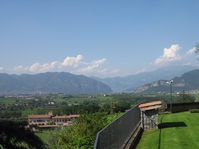|
|
 |

I like Prosecco as much as the next guy. Maybe as much as the next two or three guys. But Prosecco has its limitations, and if you want to taste how very good Italian sparkling wine can be, you’ll need to travel the road that runs through Franciacorta.
You won’t mind the trip--provided that you don’t have anything against gorgeous scenery, fabulous wine, and some of the best food in Italy. When traveling there in June, I shot about a million photos and ate like a fiend, but I’d better stay focused on the wines, which are  probably the most under-appreciated sparklers in the entire world. probably the most under-appreciated sparklers in the entire world.
A decade ago, that title belonged to Prosecco. Fifty million bottles of it were being sold in Europe at that point, but it was virtually unknown in other markets around the world, including the United States. I wrote repeatedly about Prosecco back then, extolling it as a great alternative to Champagne for informal occasions. When people aren’t concerned about complexity and class, and just want a glass of fresh, fruity, foamy fun, Prosecco fits the bill perfectly.
But again, Prosecco has its limitations, and indeed there’s no doubt that the average quality of Prosecco is declining at the moment due to its sheer popularity. But back to those limitations: Prosecco is fresh on account of being made by the charmat (bulk) process, but it is also relatively simple for that reason, and incapable of improving with bottle ageing. It is fruity and expressive because Prosecco is a grape variety at the floral end of the spectrum (near Riesling but not at the extreme with Muscat or Gewurztraminer). “Fruity and expressive” seems just right when you want a glass of bubbly by the swimming pool, but it looks a lot less appropriate by candlelight. I’m sorry, but at an elegant dinner, Prosecco looks like a Hawaiian shirt.
Don’t kill the messenger: I’m not telling you that you shouldn’t hang out by the pool with a Hawaiian shirt and a glass of Prosecco. All I’m saying is that you’d better change that shirt before going out to dinner--or you’ll look like a dork.
You get the idea, so let me be more direct: Italy makes sparkling wines that are a lot more interesting than the average Prosecco, and this is the perfect time of year to try them. A few excellent sparklers are made in  Trentino (including the amazing wines of Ferrari), but Italy’s most important source for outstanding bubblies is--without question--Franciacorta. Trentino (including the amazing wines of Ferrari), but Italy’s most important source for outstanding bubblies is--without question--Franciacorta.
Franciacorta’s wines are closer to Champagne than to Prosecco along the sparkling style continuum, owing to two factors: Champagne and Franciacorta both use the méthode traditionelle of performing the second fermentation in the bottle, and both base their cuvées predominantly on Chardonnay and Pinot Noir. (Geek Alert: Just as Champagne employs a third grape, Pinot Meunier, there’s a little Pinot Bianco used in Franciacorta.)
Although Franciacorta smells and tastes more like Champagne than Prosecco, it remains distinctively Italian in important respects, and it shows a prominent streak of locality as well. The growing district is perched in the front range of the Alps, and is north of the Rhône in terms of latitude, but still significantly south of Champagne. Consequently, average temperatures are a little warmer, and there’s a little less acidity in the wines, resulting in a somewhat softer style in a bottle from Franciacorta than one from Champagne--if there’s no difference in the buffering sweetness in the dosage added when the wine is finished. However, while Franciacorta is a bit softer and more inviting, it is less floral and fruity than Prosecco, with greater complexity, minerality, and capacity for improvement from ageing.
Just as the wines of Franciacorta occupy a distinctive place on the sparkling style spectrum, they also bear the marks of their place of origin. This is the “prominent streak of locality” that I mentioned above, and it results from the particularity of the growing region. The sources of distinctiveness are several:
First, the production zone is small, less that one-tenth the size of the Champagne region.
Second, being small, the region’s growing conditions are strongly coherent, and the internal variations in soil and microclimate have been studied very closely. Most of the surface area consists of a single, broad amphitheater fanning up from the beautiful Lake Iseo, and virtually all of the vines are planted in glacial moraine. There are differences from place  to place, with more sand, lime, clay or gravel in particular spots, but everybody knows what lies where, and what variety grows best in almost any particular place. to place, with more sand, lime, clay or gravel in particular spots, but everybody knows what lies where, and what variety grows best in almost any particular place.
Third, production techniques are very stringently regulated, and indeed the name “Franciacorta” on a label bespeaks both a specific place and a specific production regimen, as in Champagne.
Fourth, most of the wine--fully 90%--is made by small- to medium-sized producers working with estate-grown fruit, so there’s no mass production pointed toward some international style, but rather a very high quality average based on an inward-looking, self-confident craft culture based on an understanding of what works best in this particular place.
Although Franciacorta is a relatively young appellation (granted DOC in 1967 and DOCG in 1995), it now seems remarkably developed and established. Successful too, as Italians know and love the wines and consume 88% of what is produced, despite the fact that the wines are rather expensive. Of course, selling that high a percentage to any one market is putting a lot of eggs in just one basket. Since economic conditions in Italy are pretty dicey at the moment, it is easy enough to understand the fact that Franciacorta producers are now working both individually and collectively to heighten their presence in export markets.
That’s where you come in. More bottlings of Franciacorta are available for sale right now in more places around the world than ever before, and it just happens to be mid-December, so the time could hardly be better for you to pony up to try a taste of Italian excellence in sparkling wine.
You’ve got several styles at your disposal. The most widely available is Brut, which is dry (but not austere) and has very broad appeal. Three sweeter styles are also made, but the only one you’re ever likely to see in North America is Extra Dry. If you’ve got a bit of a sweet tooth, or just like very soft wines, you might give this style a try. However, since Franciacorta is already softer than Champagne, I’d steer you toward Brut instead as a starter wine. For the sake of completeness, the other two styles that are sweeter still are Sec and Demi-Sec.
Aside from Brut, there are four other important styles to consider. Rosé can be quite good, and the question of whether you’ll like this more or less than other Franciacorta styles probably boils down to whether you really like Rosé Champagne. My personal preference leans away from Rosés sparklers in general, so I’m only moderately enthusiastic about this category.
More distinctive and interesting is the Satèn style, which is a copyrighted term for a “satiny,” rather “creamy” style made primarily from Chardonnay, finished fairly dry, and bottled with lower effervescent pressure (like crémant in France). Satèn is doing quite well commercially, and many tasters love the soft texture of these wines, so I’d encourage you to give them a try.
My favorite category is the driest, labeled as Extra Brut or--drier still--“Non-Dosato,” which is sometimes called “Pas Dose” or “Dosage  Zero.” To my taste, Franciacorta is naturally soft enough to show beautifully with very low or no added sugar, and I love the freshness, energy and drive of the wines. Zero.” To my taste, Franciacorta is naturally soft enough to show beautifully with very low or no added sugar, and I love the freshness, energy and drive of the wines.
Finally, vintage-dated or “Millesimato” renditions are expensive but fabulous. Aged for a minimum of 30 months on yeast lees and 37 months total, these are wonderfully expressive in aroma and very deep and complex in flavor. The best ones are a threat to almost anything made in Champagne.
The wines profiled below were the best examples that I tasted in Franciacorta. It may be difficult to find any particular wine reviewed here, but with a bit of persistence you'll surely be able to find a few of them to taste, and all of them are well worth a search.
Monte Rossa Franciacorta Blanc de Blancs Extra Brut “Salvadek” 2007, $45: This is unmistakable as a wine of the very highest quality in all respects. The aromas are very complex and the flavors are intricate, layered and persistent. Perhaps most impressive is the texture, which is marked by extremely fine effervescence. The acid balance to sweetness is, well, perfect, making for a wine that is at once rich and refreshing. This is the sort of wine that should be keeping the Champenois awake at night. 94
Barone Pizzini Franciacorta Riserva “Bagnadore” 2005, $40: Under appellation regulations for Franciacorta, “Riserva” means that a wine has spent a minimum of 5 years on its yeast lees, and these wines are always vintage-dated. All of the base wine was barrel fermented in this instance, and after disgorging, it was finished with no dosage. Subtly yeasty, with mineral notes so pronounced that it seems almost saline in character, this is a striking wine of exceptionally high quality. Tart apple fruit notes are very appealing, and it is very complex due to positive oxidation. Extremely impressive. 93
Berlucchi Franciacorta Non-Dosato Riserva “Casa delle Colonne” 2005, $40: Strikingly complex and sharply detailed, this is a remarkable wine blended from 90% Chardonnay and 10% Pinot Noir. Aged on its yeast lees for a full 72 months, this is nevertheless very bright and fresh, with excellent crispness and drive accentuated by very fine-grained effervescence. 93
Ricci Curbastro Franciacorta Dossagio Zero “Gualberto” 2004, $46: I tasted this from a magnum that was disgorged in 2010. Although the size of the bottle and the fact that the wine was never transported makes me wonder how representative it is of the stock available in commercial channels around the world, it was so spectacular that I cannot fail to review it. Blended from 70% Chardonnay and 30% Pinot Noir, it shows lots of dramatic yeasty aromatic complexities but is extremely crisp and fresh on the palate, with flavors of fresh lemons and green apples driven by seemingly electric acidity. 93
Barone Pizzini Franciacorta Millesimato 2008, $35: An excellent wine that offers expressive aromas and satisfying flavors but is nevertheless very fresh, with a lifted, lemony edge and excellent linear energy. 92
Ronco Calino Franciacorta Non Dosaggio “Nature” 2008, $32: Lean, racy and very persistent in flavor, this is an exemplary Franciacorta made from 80% Chardonnay and 20% Pinot Noir. Light and lemony at first blush, it shows surprising intensity and drive thanks to energetic acidity that powers through the effervescence and lingers agreeably on the palate. 92
Majolini Franciacorta Millesimato Pas Dose 2006, $38: Absolutely dry in character but somehow not austere, this remarkable wine is surpassingly fresh, with notes of Granny Smith apples up front that give way to even fresher lemon notes in the finish. A model of clarity and refreshment. 92
Villa Crespia Franciacorta Dosaggio Zero “Numero Zero” NV, $28: The winemaking team at Villa Crespia makes fully 20% of its sparkling wines in this ultra-dry style, which they predict will eventually become the leading category for all of Franciacorta. I’m not certain that they’ll be correct in this prediction, but I certainly hope that they are. Made entirely from Chardonnay, this shows an aromatic and flavor profile recalling apple skin and lemon that works very well with this lean, fresh, driving style. Strikingly bright and crisp but neither austere nor sour, this is terrific. 92
Bellavista Franciacorta Brut “Grande Cuvée” NV, $55: Stored for a minimum of five years with the spent yeast from its second fermentation, this is definitely a luxury wine, with complexity and price that come with the territory. Expressive in aroma and authoritative and persistent in flavor, this is a sparkler with real muscle, yet also one with grace, thanks to the balance and integration lent by extended ageing. 92
Bellavista Franciacorta Rosé “Grande Cuvée” 2007, $75: It may be a minority view these days, but I am not a lover of Rosé sparklers, so this wine had a couple of strikes against it from the get-go. However, it succeeds brilliantly. Pale salmon color is quite attractive, and the wine shows subtle aromas and flavors that are layered and enduringly interesting. Still focused and firm, this will actually improve for a few more years of cellaring, though few who taste it will retain the patience required to test that proposition. 92
Majolini Franciacorta “Electo” Brut 2005, $35: Crafted from 80% Chardonnay and 20% Pinot Noir, this big, broad, foamy wine shows very expressive fruit but somehow manages to firm up in the finish to seem zesty and fresh. Very different in profile from the Majolini Pas Dose, this shows the versatility of this house quite impressively. 92
Barone Pizzini Franciacorta Extra Brut NV, $28: Made predominantly from Chardonnay with 5% Pinot Noir added in for good measure, this is broader and deeper in flavor than this producer’s nice Brut, and that it achieves these characteristics with a lower dosage level is particularly impressive, and is attributable to an additional year of ageing (and perhaps also to superior grape material). 91
Monte Rossa Franciacorta Brut Rosé “P.R.” NV, $40: A very successful Franciacorta Rosé, this shows pleasantly rooty, robust character from the 40% Pinot Noir from which it was crafted. Yet it never seems heavy or ponderous, thanks to fresh acidity underlying its full-bodied style, as well as energetic, foamy effervescence. 91
Monte Rossa Franciacorta Blanc de Blancs Brut “P.R.” NV, $35: This wine is a blend of younger and older stocks, and consequently shows a soft, creamy side as well as a more energetic undercurrent that provides drive and length. Aromas and flavors of fresh lemon and baked apple are very alluring, and though the wine is notably sweet, it finished with fine clarity. 91
Villa Crespia Franciacorta Brut “Riserva dei Consoli” NV, $44: This very well made non-vintage brut shows excellent balance that enables it to seem--at once--impressively deep in flavor but also quite fresh. The yeast accents are subtle and the acidity is energetic, so while the wine shows real power and persistence, it remains refreshing and clean. 91
Bellavista Franciacorta “Saten” NV, $55: This is among the best bottlings of Franciacorta Saten available, and a great choice for giving this soft style a fair try. It stands out thanks to a cleaner, more focused character and better acidic structure than the run of the Saten mill, perhaps because the vineyard sites chosen as sources for this are all at upper elevations. Excellent. 91
Barone Pizzini Franciacorta Satèn Millesimato 2008, $36: Although I lament the fact that the Satèn category is overshadowing the drier wines of Franciacorta in commercial terms, there’s no disputing the fact that the best wines in this style are extremely appealing. Fully 35% of the base wine for this cuvée was barrel fermented, and with lower effervescence than typical sparklers, this comes off as a big, creamy, luxurious wine. Nevertheless, it is balanced and sufficiently fresh to work very well as an aperitif or as a partner for fairly delicate foods. 91
Bellavista Franciacorta Brut “Cuvée” NV, $39: This is Bellavista’s most widely available wine, and it is well represented by Empson USA, giving American consumers a good chance of actually finding a bottle to try. It is distinctively rich, with a pleasantly creamy texture, yet it finishes with admirable focus and clarity. 90
|
 |
|